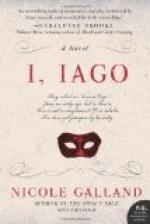|
This section contains 10,074 words (approx. 34 pages at 300 words per page) |

|
SOURCE: “The Certainty of Evil: Richard III and Othello,” in Shakespeare and the Dialectic of Certainty, St. Martin's Press, 1992, pp. 93-112.
In the following essay, Jacobus analyzes two of Shakespeare's most thoroughly evil and manipulative characters, Richard III and Iago.
A dozen years separate the writing of Richard III (1591-92) and Othello (1602-04).1 Shakespeare's consistency of vision over a decade establishes the essence of evil in two characters who both possess a high degree of certainty and misuse it. The manner in which Richard and Iago manipulate the surfaces of reality regarding themselves—establishing apparently trustworthy postures and personalities—is shared in both plays, but only up to a point.2 Richard is soon revealed for what he is, but his knowledge of Christian psychology is such that his capacity for achieving his ends is hardly affected for the worse. His ability to see and understand the qualities of...
|
This section contains 10,074 words (approx. 34 pages at 300 words per page) |

|


